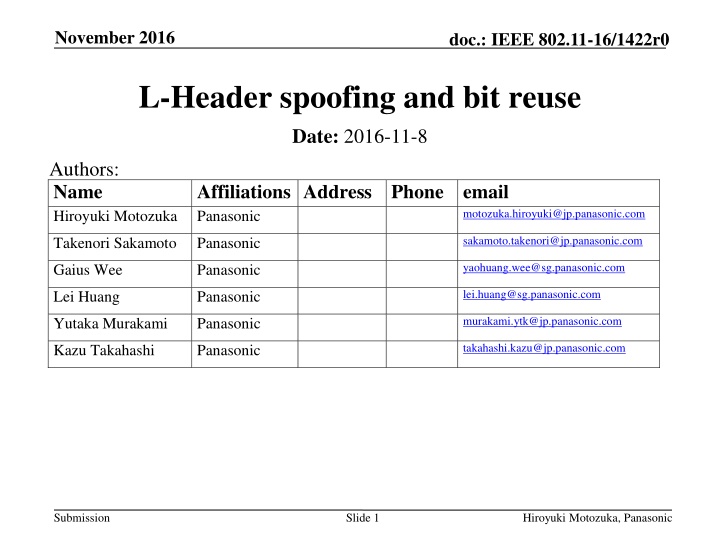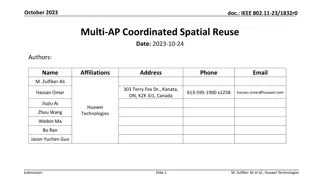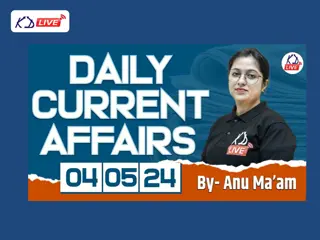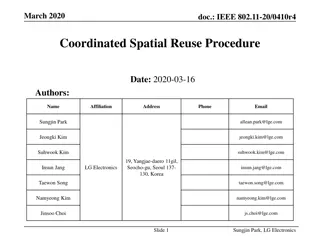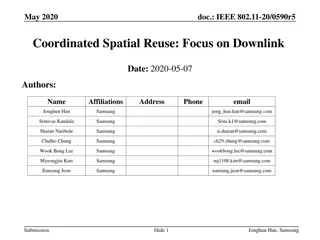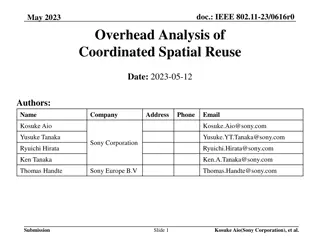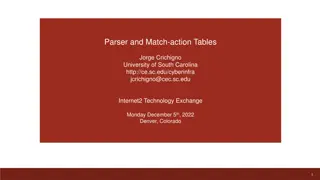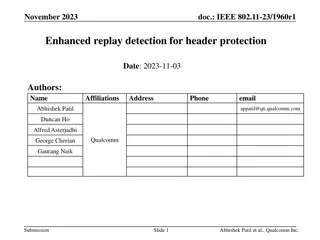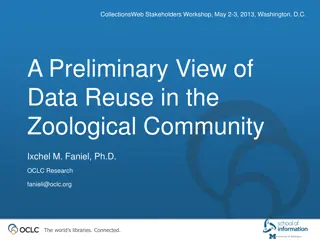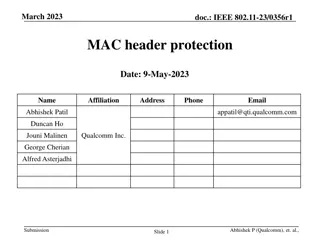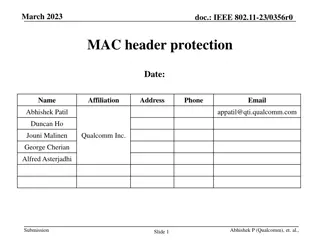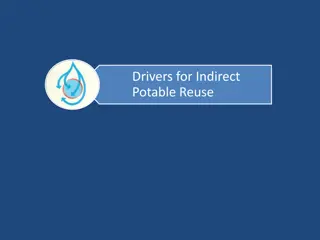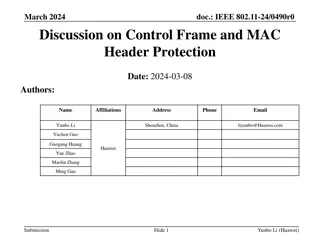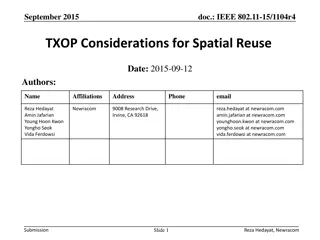L-Header Spoofing and Bit Reuse in IEEE 802.11-16
Investigation into spoofing the L-Header in IEEE 802.11-16 to enhance Efficiency Dynamic Multi-User Multiple Input Multiple Output (EDMG), focusing on reusing bits in the Length field. The presentation discusses the background, spoofing overview, and calculation of maximum TXTIME for EDMG to optimize PPDU duration and efficiency. Legacy STAs' calculation of TXTIME and considerations for compatibility with 11ad are explored.
Download Presentation

Please find below an Image/Link to download the presentation.
The content on the website is provided AS IS for your information and personal use only. It may not be sold, licensed, or shared on other websites without obtaining consent from the author.If you encounter any issues during the download, it is possible that the publisher has removed the file from their server.
You are allowed to download the files provided on this website for personal or commercial use, subject to the condition that they are used lawfully. All files are the property of their respective owners.
The content on the website is provided AS IS for your information and personal use only. It may not be sold, licensed, or shared on other websites without obtaining consent from the author.
E N D
Presentation Transcript
November 2016 doc.: IEEE 802.11-16/1422r0 L-Header spoofing and bit reuse Date: 2016-11-8 Authors: Name Hiroyuki Motozuka Affiliations Address Phone email Panasonic motozuka.hiroyuki@jp.panasonic.com sakamoto.takenori@jp.panasonic.com Takenori Sakamoto Panasonic yaohuang.wee@sg.panasonic.com Gaius Wee Panasonic lei.huang@sg.panasonic.com Lei Huang Panasonic murakami.ytk@jp.panasonic.com Yutaka Murakami Panasonic takahashi.kazu@jp.panasonic.com Kazu Takahashi Panasonic Submission Slide 1 Hiroyuki Motozuka, Panasonic
November 2016 doc.: IEEE 802.11-16/1422r0 Background 4 reserved bits in L-Header are running out while more free bits in L-Header are desired for EDMG. 2 bits in use 1+ bit should be kept for future use Field name Num. of bits Start bit Scrambler Initialization 7 0 MCS Length 5 7 18 12 In this presentation we consider reuse of the Length field in L-Header for EDMG. Additional PPDU 1 30 Packet Type 1 31 Training Length 5 32 Aggregation 1 37 Beam Tracking Request 1 38 Extended SC MCS Indication 1 44 Last RSSI 4 39 Reserved 1 45 Turnaround 1 43 EDMG (EDMG-Header-A) Indication 1 46 Reserved 4 44 Reserved 1 47 HCS 16 48 Submission Slide 2 Hiroyuki Motozuka, Panasonic
November 2016 doc.: IEEE 802.11-16/1422r0 Spoofing overview In an EDMG PPDU, actual MCS and length are included in the EDMG-Header-A/B [1]. The L-Header includes spoof MCS and length so that legacy STAs can compute the TXTIME of the EDMG PPDU. EDMG PPDU TXTIME EDMG- Header-A L-STF L-CEF L-Header E-STF E-CEF Data spoof MCS, Length actual MCS, Length Legacy STA sees: TXTIME calculated by spoof MCS and Length L-STF L-CEF L-Header DMG payload [1] 11-16/1358r6 Specification Framework for TGay Submission Slide 3 Hiroyuki Motozuka, Panasonic
November 2016 doc.: IEEE 802.11-16/1422r0 maximum TXTIME for EDMG The maximum duration of a DMG PPDU (aPPDUMaxTime) is 2ms. We suggest to specify that the maximum duration of an EDMG PPDU is 2 ms, as same as DMG. Significant efficiency improvement may not be expected with a longer PPDU. Overhead for preamble and BA could be less than 1% (20us) for 2ms PPDU. Potential risks of compatibility with 11ad are reduced. We haven t seen any problems which encourage to reduce the maximum duration. Submission Slide 4 Hiroyuki Motozuka, Panasonic
November 2016 doc.: IEEE 802.11-16/1422r0 How does legacy STA calculate TXTIME? Example: DMG SCPHY MCS6 (see appendix for the details) ????? 42 672 896 ??????[??] = 512 + 4416 /1760 Data octets per LDPC codeword Data bits per Symbol block Submission Slide 5 Hiroyuki Motozuka, Panasonic
November 2016 How does legacy STA calculate TXTIME? (cont d) doc.: IEEE 802.11-16/1422r0 Since 11ad SC-PHY employs LDPC coding, and the packet consists of SC-FDE blocks, there are multiple length values which have the same TXTIME. the same TXTIME Symbol Block 512 sym MCS 6 Length=127 Preamble/Header Data 448sym GI padding bits, padding symbols 64sym Length=168 Preamble/Header Submission Slide 6 Hiroyuki Motozuka, Panasonic
November 2016 How does legacy STA calculate TXTIME? (cont d) doc.: IEEE 802.11-16/1422r0 In case of MCS6 for example, there are at least 42 length values which have the same TXTIME. ????? 42 3 4 ??????[??] = 512 + 4416 /1760 Length = 42n+1 ~ 42n+42 have the same TXTIME This means the lower bits of the Length field in L-Header are not important for TXTIME calculation. Submission Slide 7 Hiroyuki Motozuka, Panasonic
November 2016 doc.: IEEE 802.11-16/1422r0 Reuse of Length field in L-Header We suggest to reuse LSBs of the Length field in the L-Header for EDMG purpose. Bandwidth preview will be proposed[2] EDMG PPDU TXTIME EDMG- Header-A L-STF L-CEF L-Header E-STF E-CEF Data spoof MCS, Length actual MCS, Length LSBs: reused for EDMG purpose MSBs: used for TXTIME indication (spoofing) [2]11-16/1395r0 EDMG Header-A Fields preview in L-Header Submission Slide 8 Hiroyuki Motozuka, Panasonic
November 2016 doc.: IEEE 802.11-16/1422r0 How many bits can be reused? The number of reusable bits depends on the spoof MCS in the L-Header. (see appendix for the details) 5 bits will be available if we use MCS 2 or above for spoof MCS. MCS in L-Header MCS in L-Header Reusable bits Reusable bits 1 4 7 5 2 5 8 5 3 5 9 6 4 5 10 6 5 6 11 6 6 5 12 6 Submission Slide 9 Hiroyuki Motozuka, Panasonic
November 2016 doc.: IEEE 802.11-16/1422r0 Consideration for spoof MCS By using MCS 2 or 3, spoofing is properly performed for up to 2ms PPDUs. We suggest to rule out use of MCS1 for spoofing, while use MCS2 or above. TXTIME of DMG PPDUs when Length=262143 (max. in 11ad) 5.46 Submission Slide 10 Hiroyuki Motozuka, Panasonic
November 2016 doc.: IEEE 802.11-16/1422r0 Summary of Length bits reuse We suggest to use 5 LSBs of Length field in L-Header for EDMG purpose. EDMG PPDU TXTIME : no grater than 2ms EDMG- Header-A L-STF L-CEF L-Header E-STF E-CEF Data spoof MCS, Length actual MCS, Length set to MCS2 or above 13 MSBs: used for TXTIME indication (spoofing) 5 LSBs: reused for EDMG purpose Submission Slide 11 Hiroyuki Motozuka, Panasonic
November 2016 doc.: IEEE 802.11-16/1422r0 Conclusion We propose to define the maximum PPDU duration of EDMG PPDU as 2ms. We show that 5 LSBs of Length field in L-Header can be reused for EDMG purpose. Submission Slide 12 Hiroyuki Motozuka, Panasonic
November 2016 doc.: IEEE 802.11-16/1422r0 References [1] 11-16/1358r6 Specification Framework for TGay [2] 11-16/1395r0 EDMG Header-A Fields preview in L- Header Submission Slide 13 Hiroyuki Motozuka, Panasonic
November 2016 doc.: IEEE 802.11-16/1422r0 Straw poll Do you agree to add the following to the SFD The maximum PPDU duration of EDMG PPDU is 2ms." Submission Slide 14 Hiroyuki Motozuka, Panasonic
November 2016 doc.: IEEE 802.11-16/1422r0 Appendix Submission Slide 15 Hiroyuki Motozuka, Panasonic
November 2016 doc.: IEEE 802.11-16/1422r0 TXTIME calculation in DMG SC TXTIME of DMG PPDU is computed as follows TXTIME[us] = ((2176+1152+64) + (2+NBLKS) * 512)) / 1760 MHz STF CEF GI followed by Header Header Payload Symbols/Block MCS = (NBLKS*512+4416)/1760 NBLKS is calculated as follows 1 672/448 = 3/2 21 2 672/448 = 3/2 42 3 672/448 = 3/2 52.5 ??? ??? ????? ????? 8 ??? ? ??? ????? ?????= = 4 672/448 = 3/2 63 ? 5 672/448 = 3/2 68.25 ????? ? 6 672/896 = 3/4 42 = ? 7 672/896 = 3/4 52.5 Thus, TXTIME is: 8 672/896 = 3/4 63 ????? ? ??????[??] = ? 512 + 4416 /1760 9 672/896 = 3/4 68.25 10 672/1792 = 3/8 42 parameters (dependent of modulation) and (dependent of coding rate) are shown in the table. 11 672/1792 = 3/8 52.5 12 672/1792 = 3/8 63 Submission Slide 16 Hiroyuki Motozuka, Panasonic
November 2016 doc.: IEEE 802.11-16/1422r0 The number of reusable bits There are at least w choices of the length value in L-Header for the given TXTIME. b LSBs of the Length field in L-Header can be reused, where ? = ????? ? = ? ?/? MCS w b 1 3/2 21 21 4 2 3/2 42 42 5 3 3/2 52.5 52 5 4 3/2 63 63 5 5 3/2 68.25 68 6 6 3/4 42 42 5 7 3/4 52.5 52 5 8 3/4 63 63 5 9 3/4 68.25 68 6 10 3/8 42 84 6 11 3/8 52.5 104 6 12 3/8 63 126 6 Submission Slide 17 Hiroyuki Motozuka, Panasonic
November 2016 doc.: IEEE 802.11-16/1422r0 Example of spoof Length calculation Without reuse of 5 LSBs ????? = ? ???: ? = (?????? 1760 4416)/512 ? ? ??? ?? ? ???????? ??????? MCS w b 1 3/2 21 21 4 ?/? ? 2 3/2 42 42 5 3 3/2 52.5 52 5 4 3/2 63 63 5 5 3/2 68.25 68 6 With reuse of 5 LSBs (r : the value in reused 5 bits) ? = (?????? 1760 4416)/512 ? = ?/? ? ? = 0 32 ?? ?????? ????? = (? ? ??? 32 + ?) ? replace the 5 LSBs of L with r correction for keeping 6 3/4 42 42 5 7 3/4 52.5 52 5 8 3/4 63 63 5 9 3/4 68.25 68 6 10 3/8 42 84 6 ? ??? 32 ? 11 3/8 52.5 104 6 12 3/8 63 126 6 the desired TXTIME Submission Slide 18 Hiroyuki Motozuka, Panasonic
